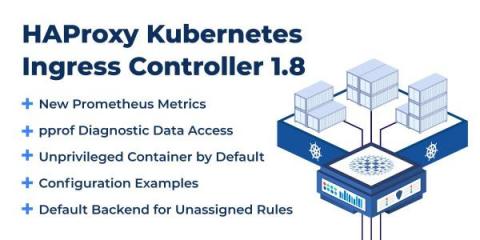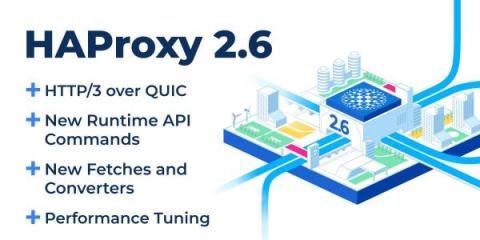Operations | Monitoring | ITSM | DevOps | Cloud
HAProxy
Fostering Fearlessness: Working in the Middle of the Day Instead of the Middle of the Night
Custom Resources with HAProxy Kubernetes Ingress Controller
HAProxy Kubernetes Ingress Controller provides custom resources named Backend, Defaults, and Global that let you manage ingress controller settings more efficiently. To start using them right away, check the documentation for steps and examples. In this blog post, you’ll learn why custom resources are such a powerful feature and see tips for getting the most out of them.
Announcing HAProxy Kubernetes Ingress Controller 1.8
We’re proud to announce the release of version 1.8 of the HAProxy Kubernetes Ingress Controller! In this release, we added support for full rootless mode, Prometheus metrics for the controller itself, and examples that are synchronized with our Helm chart. In this blog post, you will learn more about the changes in this version. Register for our webinar to learn more about this release.
Announcing HAProxy 2.6
HAProxy 2.6 is now available! As always, the community behind HAProxy made it possible to bring the enhancements in this release. Whether developing new functionality, fixing issues, writing documentation, QA testing, hosting CI environments, or submitting bug reports, members of our community continue to drive the project forward. If you’d like to join the effort, you can find us on GitHub, Slack, Discourse, and the HAProxy mailing list.
Use the Proxy Protocol to Preserve a Client's IP Address
In this blog post, you’ll learn how the Proxy Protocol preserves a client’s IP address when that client’s connection passes through a proxy. You will also find resources for how to integrate the protocol into your own proxy or web server software. What is the Proxy Protocol? It is a network protocol for preserving a client’s IP address when the client’s TCP connection passes through a proxy.
Enable Sticky Sessions in HAProxy
HyperText Transfer Protocol (HTTP), the protocol that defines the language browsers use to communicate with web servers, is stateless, meaning that after you make a web request and a server sends back a response, no memory of that interaction remains. To make anything more sophisticated than a static web page work, websites need other ways to remember previous interactions with users.
[Live Webinar] Achieving Multi-Datacenter High Availability with HAProxy ALOHA and GSLB
HAProxy ALOHA is a load balancer that’s ideal for companies in search of high performance and ease of use. It comes as either a hardware appliance or a virtual appliance and provides load balancing of TCP, UDP and HTTP traffic, DDoS protection, and active-active clustering. One of its newest features is the ability to distribute traffic across multiple datacenters or regions through global server load balancing(GSLB).
April/2022 - CVE-2022-22965: Spring4Shell Remote Code Execution Mitigation
Recently, a Remote Code Execution vulnerability was discovered in the Java Spring Core library. This vulnerability allows attackers to execute arbitrary code on affected systems. You can find more information on that vulnerability in the announcement on the Spring Blog. While HAProxy Enterprise, HAProxy ALOHA, and other products within the HAProxy Technologies portfolio are not impacted by this (they do not use the Spring Core library at all), you can use our products to mitigate the attack.
Use Your Load Balancer to Monitor Application Health
HAProxy and HAProxy Enterprise collect a vast amount of information about the health of your applications being load balanced. That data, which uses the Prometheus text-based format for metrics, is published to a web page hosted by the load balancer, and since many application performance monitoring (APM) tools can integrate with Prometheus, it’s likely that you can visualize the data using the APM software you already have.











